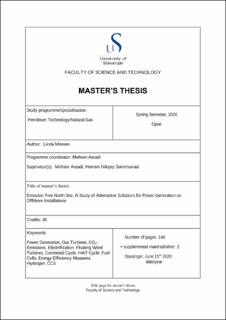| dc.contributor.advisor | Assadi, Mohsen | |
| dc.contributor.author | Monsen, Linda | |
| dc.date.accessioned | 2020-10-28T12:34:30Z | |
| dc.date.available | 2020-10-28T12:34:30Z | |
| dc.date.issued | 2020-06-15 | |
| dc.identifier.uri | https://hdl.handle.net/11250/2685508 | |
| dc.description | Master's thesis in Petroleum engineering | en_US |
| dc.description.abstract | As a contribution to the 2°C goal of the Paris Agreement, The Norwegian Oil and Gas Association aims to reduce their GHG emissions to 40% of the 2005 level by 2030 and to have zero emissions by 2050. Gas turbines producing electricity and mechanical work on offshore installations was accountable for 66.7% of the petroleum industry's GHG emissions in Norway in 2018, due to their low efficiency and high CO2-emission factor.
This thesis has reviewed nine different alternatives to the conventional simple cycle gas turbine for power generation on offshore installations, with a goal in mind to find a more sustainable alternative for energy production, which will contribute to a substantial CO2-emission reduction at an affordable cost. The 2018 energy requirements for Greater Ekofisk Area has been chosen as a basis for energy calculations.
Partial electrification would contribute to the highest guaranteed CO2-emission reduction of 20.8%, however at the highest cost of 2 995 NOK/ton CO2 reduced. Combined cycle, HAT cycle and fuel cells would all increase the efficiency of the power generation and contribute to a CO2-emission reduction of approximately 7%. Energy Efficiency Measures involving optimization of equipment to reduce energy loss and limiting operative time on injection pumps have already contributed to a CO2-emission reduction of 5.5% for the insignificant abatement cost of 0.73 NOK/ton CO2 reduced. Producing hydrogen through SMR and combusting a fuel blend of NG/H2 in gas turbines would increase the final CO2-emission level by 7.6%. Pre-combustion capture of CO2 from the SMR process would however decrease the CO2-emissions with 15.1% for an abatement cost of 584 NOK/ton CO2 reduced. The cost does not include transportation and final storage of CO2. Carbon capture from fuel cells by oxy-fuel combustion would reduce CO2-emissions with 20.8%. The technology for a medium ranged, compact fuel cell, capable of operating on natural gas is however still under development.
Finally, floating wind turbines supplying the offshore installations with electricity stands out as the most suitable alternative, with potential of decreasing CO2-emissions with 20.8% for an abatement cost of 1 156NOK/ton CO2 reduced. | en_US |
| dc.language.iso | eng | en_US |
| dc.publisher | University of Stavanger, Norway | en_US |
| dc.relation.ispartofseries | Masteroppgave/UIS-TN-IEP/2020; | |
| dc.rights | Navngivelse 4.0 Internasjonal | * |
| dc.rights.uri | http://creativecommons.org/licenses/by/4.0/deed.no | * |
| dc.subject | petroleumsteknologi | en_US |
| dc.subject | petroleum engineering | en_US |
| dc.subject | power generation | en_US |
| dc.subject | gas turbines | en_US |
| dc.subject | CO2-emissions | en_US |
| dc.subject | electrification | en_US |
| dc.subject | floating wind turbines | en_US |
| dc.subject | combined cycle | en_US |
| dc.subject | HAT cycle | en_US |
| dc.subject | fuel cells | en_US |
| dc.subject | energy efficiency measures | en_US |
| dc.subject | hydrogen | en_US |
| dc.subject | ccs | en_US |
| dc.title | Emission Free North Sea: A Study of Alternative Solutions for Power Generation on Offshore Installations | en_US |
| dc.type | Master thesis | en_US |
| dc.subject.nsi | VDP::Teknologi: 500::Berg‑ og petroleumsfag: 510::Petroleumsteknologi: 512 | en_US |

